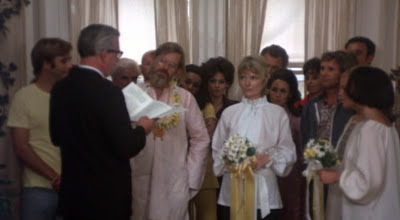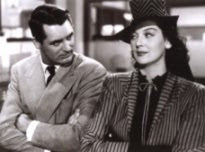 Ever since the recent passing of Doris Day, my mind has occasionally found itself preoccupied with another actress, the irrepressible Janis Paige, largely because of the connection between the two.
Ever since the recent passing of Doris Day, my mind has occasionally found itself preoccupied with another actress, the irrepressible Janis Paige, largely because of the connection between the two.In terms of the Hollywood-&-Vine axis, Paige was a B star, actually a co-star. Yeah, maybe on paper. But in reality, on the big screen, whatever film she was in, she commanded as only a Star can.
Her filmography is varied and lengthy but in her most entertaining performances, Paige played randy women of a certain age with va-va-voom in her eyes and a chilled Martini in hand - her hair seeming red even when it was blonde: Charles Walters' "Please Don't Eat the Daisies" (1960) and Jack Arnold's "Bachelor in Paradise" (1961). For me, she's always been a hands-down pleasure to watch and I get an added kick from Paige being a fellow Virgo. (We share the same birthday.)
For all intents and purposes, she had what I call the Kay Thompson role in Rouben Mamoulian's film of Cole Porter's "Silk Stockings" (1975). Surely you remember her one big scene, belting out and dancing with antic glee with Fred Astaire in the "Stereophonic Sound" number (choreographed by Hermès Pan, with an assisst from Eugene Loring). She was no substitute here. In "Silk Stockings," Paige pretty much out-Thompsons Thompson.
Her lead film roles usually cast Paige opposite Jack Carson or Dennis Morgan, again in B movies. True stardom came on stage in 1954 when she appeared as Babe Williams, the in-your-face head of a labor union's grivance committee in the Rose-Adler musical, "The Pajama Game," playing opposite John Raitt. When Warner Bros. bought the film rights for the show, Jack Warner was intent on casting the entire Broadway cast to reprise their roles, except for a major name in one of the two leads.
It was a crap shoot - literally - if either Paige or Raitt would be in the film. Frank Sinatra was approached for the Raitt role - he would have played opposite Paige - but he declined. Enter Doris Day, who accepted the female lead and played opposite Raitt in the 1957 film.
Oddly enough, Paige had starred with Day in the latter's first film, Michael Curtiz' 1948 "Romance on the High Seas," and went on to appear with her in the aforementioned "Please Don't Eat the Daisies," in which they played rivals.
In 1963, Paige got another lead role in a big Broadway musical - Meredith Willson's "Here's Love," based on "Miracle on 34th Street," in which Paige played the part originated by Maureen O'Hara. But on screen during these years, the '60s, the actress rarely got to stray from her fun-gal roles - until Hall Bartlett did give her the opportunity to do a variation on this archetype in his 1963 psychodrama, "The Caretakers," in which Paige played an aging prostitute undergoing a serious meltdown.
Bartlett showcased Paige and the critics, who rather casually dismissed the film, singled her out. Like Janis, it remains a guilty pleasure.
Inarguably.
Notes in Passing: Doris Day was 97 when she passed. She is survived by at least one former co-star, Janis Paige whose birthday is September 16th. She'll be ... 97. Her last theatrical film was Burt Kennedy's "Welcome to Hard Times," released in 1967 and starring Henry Fonda, Warren Oates and Janice Rule. After that, she became a fixture in some 50 TV movies and series (often as a recurring character). Her final acting role came on "Family Law" in 2001.
 Regarding Comments:
All comments are enthusiastically appreciated but are moderated before
publication. Replies signed "unknown" or "anonymous" are not
encouraged. Please sign any response with a name (real or fabricated) or
initials. Be advised that a "name" will be assigned to any accepted
post signed "unknown" or "anonymous." Thank you. -J
Regarding Comments:
All comments are enthusiastically appreciated but are moderated before
publication. Replies signed "unknown" or "anonymous" are not
encouraged. Please sign any response with a name (real or fabricated) or
initials. Be advised that a "name" will be assigned to any accepted
post signed "unknown" or "anonymous." Thank you. -J* * * * *
~images~
(from top)
~Coctails and fliritng - Janis Paige uses both on Bob Hope in Jack Arnold's "Bachelor in Paradise"
~Publicity still of Paige for "Please Don't Eat the Daisies"
~photography: MGM 1961©
~Publicity still of Paige for "Please Don't Eat the Daisies"
~photography: MGM 1960©
~With John Raitt in the stage production of "The Pajama Game"
~photography: Friedman Abeles 1954©
~With Craig Stevens in the Meredith Willson musical "Here's Love"
~photography: Friedman Abeles 1963©
~Paige in "The Caretakers"
~Paige in "The Caretakers"
~photography: United Artists 1963©
~A typical pose for "Silk Stockings"
~A typical pose for "Silk Stockings"
~photography: MGM 1957©































